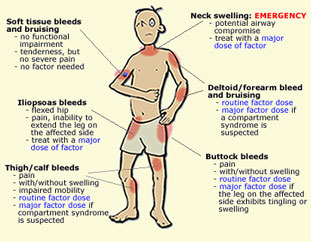Definition- It is a hereditary disorder of coagulation of blood due to deficiency of antihaemophilic globulin in the blood due to deficiency of antihaemophilic globulin in the blood resulting in haemorrhagic tendency . It is inherited as sex linked recessive disorder .Females carry the gene of the disease while the male suffer (1 in 10,000 births).
In many cases (70%) a positive family history can be obtained .Carrier mother can be identified as well as future possibility of haemophilia can be identified in foetus prenatally .In tise disorder the level of factor VIII : C is reduce but factor VIII : VWF is normal . Various genetic defects are associated with this condition .
Clinical features
This disease usually manifests itself in infancy .Males are usually affected .Bleeding usually follows a trauma .The characteristic feature of bleeding is not its profuseness but persistence .It may persist for day or even weeks .Spontaneous haemorrhage is rare. Haemorrhage occurs from the mouth, nose, alimentary tract,urinary tract,muscles,subcutaneous tissues,joints,etc.Cutaneous haemorrhage are rare though bruises may occur after slight knocks.In severe haemophiliacs recurrent haemorrhage into the joint space is common and is a disabling symptom.In children ankles are involved but in adults knee joints are commenly affected. When this occurs,fever,pain and swelling of the joints are also present.There may be repeated small haemorrhages into the joints but without any sequela.Rarely there may be chronic haemophilic arthritis with anklylosia and marked deformity. Haemorrhage into muscles and connective tissues is also seen which may lead to pain, swelling of the parts and fever. Large subperiosteal haemorrhages ,may lead to destruction of bones with calcification and x.rays shows tumor like masses called haemophilic pseudotumour of bones.
Investigations:-
1. Blood – Routine blood examination is normal, rarely there may be anaemia when the bleeding is profuse.
2. Bleeding time is normal but coagulation time is markedly prolonged. Thromboplastin generation test is abnormal. Prothrombin time is normal. Partial thrombombin time is prolonged, PTTK is increased.
3. Factor VIII level of blood is diminished. When the activity is less than 1% of normal, bleeding occurs both spontaneously and after trauma. When the level of factor VIII is above 5% of normal, bleeding occurs only after trauma and patient will have a mild clinical course.VIII: VWF is normal.
Complications
1.Haemorrhage.
2.Haemophilic arthropathy
3.Hepatitis B.
4.AIDS(Frequent cause of death
5.Hypertension.
6. Development of inhibition to factor VIII(15%)
Differential Diagnosis
Haemophilia should be differentiated from Christmas disease and von Willebrand’s disease.
Treatment in Homoeopathy- We are treated Haemophilia successfully by our Homoeo medicine

